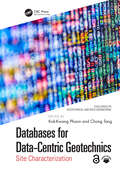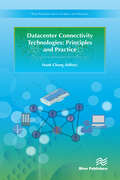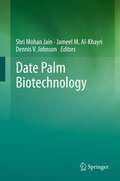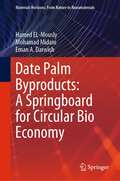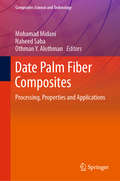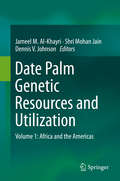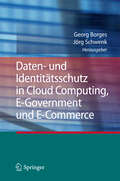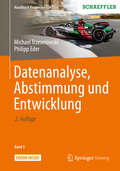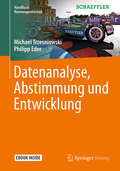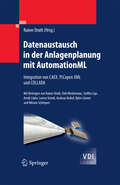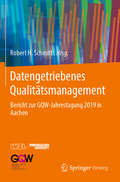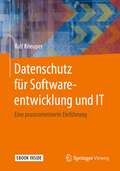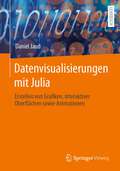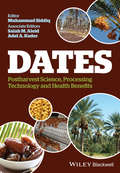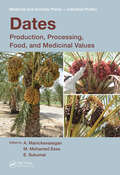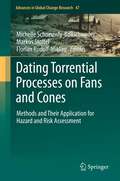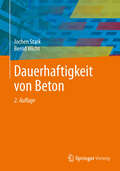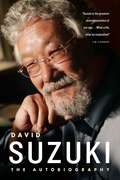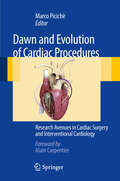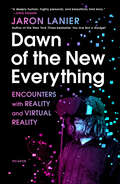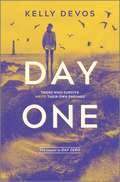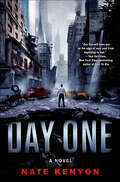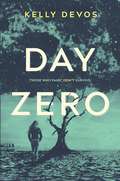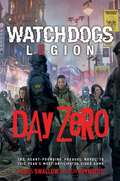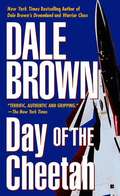- Table View
- List View
Databases for Data-Centric Geotechnics: Site Characterization (Challenges in Geotechnical and Rock Engineering)
by Kok-Kwang Phoon and Chong TangDatabases for Data-Centric Geotechnics forms a definitive reference and guide to databases in geotechnical and rock engineering, to enhance decision-making in geotechnical practice using data-driven methods. This first volume pertains to site characterization. The opening chapter presents an in-depth analysis of site data attributes, including the establishment of a new taxonomy of site data under “4S” (site generalizations, spatial features, sampling characteristics, and smart data) to provide a novel agenda for data-driven site characterization. Type 3 machine learning methods (disruptive value) are possible as sensors become more pervasive and more intelligent. A comprehensive overview of site characterization information is also presented with a focus on its availability, coverage, value to decision making, and challenges. The remaining 13 chapters cover databases of soil and rock properties and the application of these databases to rock socket behavior, rock classification, settlement on soft marine clays, permeability of fine-grained soils, and liquefaction among others. The databases were compiled from studies undertaken in many countries including Austria, Australia, Brazil, Canada, China, France, Finland, Germany, India, Iran, Japan, Korea, Malaysia, Mexico, New Zealand, Norway, Singapore, Sweden, Thailand, the United Kingdom, and the United States.This volume on site characterization is a companion to the volume on geotechnical structures. Databases for Data-Centric Geotechnics represents the most diverse and comprehensive assembly of database research in a single publication (consisting of two volumes) to date. It follows from Model Uncertainties for Foundation Design, also published by CRC Press, and suits specialist geotechnical engineers, researchers and graduate students.
Datacenter Connectivity Technologies: Principles and Practice
by Frank ChangIn recent years, investments by cloud companies in mega data centers and associated network infrastructure has created a very active and dynamic segment in the optical components and modules market. Optical interconnect technologies at high speed play a critical role for the growth of mega data centers, which flood the networks with unprecedented amount of data traffic. Datacenter Connectivity Technologies: Principles and Practice provides a comprehensive and in-depth look at the development of various optical connectivity technologies which are making an impact on the building of data centers. The technologies span from short range connectivity, as low as 100 meters with multi-mode fiber (MMF) links inside data centers, to long distances of hundreds of kilometers with single-mode fiber (SMF) links between data centers.This book is the first of its kind to address various advanced technologies connecting data centers. It represents a collection of achievements and the latest developments from well-known industry experts and academic researchers active in this field.
Date Palm Biotechnology: Tissue Culture Applications (Methods in Molecular Biology #1637)
by Shri Mohan Jain Jameel M. Al-Khayri Dennis V. JohnsonThis important reference book is the first comprehensive resource worldwide that reflects research achievements in date palm biotechnology, documenting research events during the last four decades, current status, and future outlook. This book is essential for researchers, policy makers, and commercial entrepreneurs concerned with date palm. The book is invaluable for date palm biotechnology students and specialists. This monument is written by an international team of experienced researchers from both academia and industry. It consists of five sections covering all aspects of date palm biotechnology including A) Micropropagation, B) Somaclonal Variation, Mutation and Selection, C) Germplasm Biodiversity and Conservation, D) Genetics and Genetic Improvement, and E) Metabolites and Industrial Biotechnology. The book brings together the principles and practices of contemporary date palm biotechnology. Each chapter contains background knowledge related to the topic, followed by a comprehensive literature review of research methodology and results including the authors own experience including illustrative tables and photographs.
Date Palm Byproducts: A Springboard for Circular Bio Economy (Materials Horizons: From Nature to Nanomaterials)
by Mohamad Midani Hamed EL-Mously Eman A. DarwishThis comprehensive book presents an alternative fresh look at date palm byproducts as a springboard for the future circular bio economy. The book shows and exemplifies how these sustainable biomaterials can be the base for a wide spectrum of products and uses. Examples of these numerous products and uses are demonstrated and categorized into five principal uses: i) pharmaceutical, cosmetics and natural wax ,ii) textiles and composites, cellulose and cellulose derivatives, iii)timber and wood substitutes, architecture insulation and building materials, iv) organic fertilizer, compost and soil amendment and water treatment purposes, v) natural fodder and silage , green fuels and bioenergy.
Date Palm Fiber Composites: Processing, Properties and Applications (Composites Science and Technology)
by Othman Y. Alothman Mohamad Midani Naheed SabaThis book covers the recent research advances on the utilization of date palm fibers as a new source of cellulosic fibers that can be used in the reinforcement of polymer composites. It discusses the competitive mechanical, physical, and chemical properties which make date palm fibers stand out as an alternative to other fibers currently used in the natural fiber composites market. This volume will be useful to researchers working on natural fiber composites and fiber reinforced composites looking to develop green, biodegradable and sustainable components for application in automotive, marine, aerospace, construction, wind energy and consumer goods sectors.
Date Palm Genetic Resources and Utilization: Volume 1: Africa and the Americas
by Shri Mohan Jain Jameel M. Al-Khayri Dennis V. JohnsonThis important 2-volume reference book is the first comprehensive resource reflecting the current global status and prospects of date palm cultivation by country. This volume covers Asia and Europe. The Asian countries included are: Iran, Saudi Arabia, Iraq, Pakistan, Oman, Yemen, Israel, Kuwait, Qatar, Bahrain, Syria, Palestine and India. Europe is represented by Spain. Topics discussed are: cultivation practices; genetic resources and breeding; conservation and germplasm banks; cultivar classification and identification based on morphological and molecular markers; micropropagation and progress toward scale-up production; and advances in dates processing and marketing. Chapters are supported by tables and color photographs. Appendixes summarize traits and distribution of major cultivars, commercial resources of offshoots and in vitro plants; and institutions and scientific societies concerned with date palm.
Daten- und Identitätsschutz in Cloud Computing, E-Government und E-Commerce
by Jörg Schwenk Georg BorgesFür neue und künftige Geschäftsfelder von E-Commerce und E-Government stellen der Datenschutz und der Identitätsschutz wichtige Herausforderungen dar. Renommierte Autoren aus Wissenschaft und Praxis widmen sich in dem Band aktuellen Problemen des Daten- und Identitätsschutzes aus rechtlicher und technischer Perspektive. Sie analysieren aktuelle Problemfälle aus der Praxis und bieten Handlungsempfehlungen an. Das Werk richtet sich an Juristen und technisch Verantwortliche in Behörden und Unternehmen sowie an Rechtsanwälte und Wissenschaftler.
Datenanalyse, Abstimmung und Entwicklung (Handbuch Rennwagentechnik #5)
by Michael Trzesniowski Philipp EderEinmal Renningenieur zu sein, davon träumen viele Motorsportfans und -Ingenieure. Dieses Buch gibt einen Einblick in den Arbeitsalltag eines Renningenieurs. Es werden die verschiedenen Darstellungsformen von Daten und deren Interpretation beschrieben. Dieses Wissen unterstützt die Renningenieure, Änderungen an den Einstellungen des Fahrzeugs durchzuführen aber auch Fehlerquellen zu lokalisieren. Die gewonnenen Erkenntnisse sind aber nicht nur für das momentane Rennen wichtig, auch Potentiale für eine Neuentwicklung werden daraus abgeleitet. Zusätzlich wird neben der Datenauswertung auch der gesamte Prozess vom Daten Sammeln bis hin zur Komponentenauswahl beschrieben. Fahrdynamische Betrachtungen helfen dem Renningenieur die gewinnbringende Abstimmung für einen Wagen zu finden. Die Fahrer werden bei der Suche nach Entwicklungswerkzeugen und -methoden fündig, um ihr Fahrzeug gezielt zu verbessern. Das Formelmaterial ist so aufbereitet, dass das Buch auch als Nachschlagwerk eingesetzt werden kann.
Datenanalyse, Abstimmung und Entwicklung (Handbuch Rennwagentechnik)
by Michael Trzesniowski Philipp EderEinmal Renningenieur zu sein, davon tr#65533;umen viele Motorsportfans und -Ingenieure. Dieses Buch gibt einen Einblick in den Arbeitsalltag eines Renningenieurs. Es werden die verschiedenen Darstellungsformen von Daten und deren Interpretation beschrieben. Dieses Wissen unterst#65533;tzt die Renningenieure, #65533;nderungen an den Einstellungen des Fahrzeugs durchzuf#65533;hren aber auch Fehlerquellen zu lokalisieren. Die gewonnenen Erkenntnisse sind aber nicht nur f#65533;r das momentane Rennen wichtig, auch Potentiale f#65533;r eine Neuentwicklung werden daraus abgeleitet. Zus#65533;tzlich wird neben der Datenauswertung auch der gesamte Prozess vom Datensammeln bis hin zur Komponentenauswahl beschrieben.
Datenaustausch in der Anlagenplanung mit AutomationML: Integration von CAEX, PLCopen XML und COLLADA (VDI-Buch)
by Rainer DrathDas Buch gibt erstmals einen umfassenden Überblick über die Technologie AutomationML und die Integration von CAEX, COLLADA und PLCopen XML. Mit AutomationML soll die Interoperabilität zwischen digitalen Werkzeugen im Engineering-Prozess gefördert werden. Es ist das erste kostenfrei zugängliche, offene und XML-basierte Format, das übergreifend eine Vielzahl von Planungsaspekten kombiniert. Das Buch ist ein Gemeinschaftswerk des AutomationML-Konsortiums. Es wurde so konzipiert, dass es als Kompendium und zugleich als Entscheidungshilfe dienen kann.
Datengetriebenes Qualitätsmanagement: Bericht zur GQW-Jahrestagung 2019 in Aachen
by Robert H. SchmittDie Gesellschaft für Qualitätswissenschaft e.V. GQW hat sich seit ihrer Gründung im Dezember 1994 dem Ziel verschrieben, die Qualitätswissenschaft in Lehre und Forschung zu fördern und den Wissenstransfer in die industrielle Anwendung zu unterstützen. Seit 1998 werden hierzu im Rahmen von Jahrestagungen Forschungs- und Entwicklungsergebnisse vorgestellt, die für die Qualitätswissenschaft aktuelle und relevante Themen aufgreifen.Die Jahrestagung 2019 der Gesellschaft für Qualitätswissenschaft e.V. (GQW) fand unter der Leitung von Prof. Dr.-Ing. Robert H. Schmitt am 30. Oktober in Aachen statt. Der Themenschwerpunkt adressierte die Potenziale der gesteigerten Datenverfügbarkeit und von Data Analytics für die Qualitätswissenschaft. Der Tagungsband beinhaltet die eingereichten und begutachteten Beiträge, die im Rahmen der Tagung präsentiert worden sind.
Datenschutz für Softwareentwicklung und IT: Eine praxisorientierte Einführung
by Ralf KneuperDieses Buch beschreibt das Thema Datenschutz aus der Sicht von Softwareentwicklung und IT. Die Verantwortlichen in diesen Bereichen gestalten die praktische Umsetzung des Datenschutzes zu erheblichen Teilen mit, benötigen dafür aber entsprechende Kenntnisse über die rechtlichen Rahmenbedingungen und Möglichkeiten zu deren Umsetzung. Der Fokus dieses Buchs liegt daher auf den Aspekten des Datenschutzes, die durch Softwareentwicklung stark beeinflusst werden, wie z.B. Privacy by Design, Privacy by Default, Datenminimierung, Umsetzung von Auskunftsrechten sowie Datenlöschung.
Datenvisualisierungen mit Julia: Erstellen von Grafiken, interaktiver Oberflächen sowie Animationen
by Daniel JaudDieses Buch stellt eine Einführung in das Programmieren und das Erstellen publikationsfertiger Grafiken oder interaktiver Animationen mit der Julia-Programmiersprache dar. Ein besonderes Augenmerk liegt dabei auf einer schrittweise Auseinandersetzung mit den verschiedenen Plot-Möglichkeiten. Im Buch werden aufeinander aufbauend alle wichtigen Programmierkonstrukte zum Erstellen von Grafiken ausgearbeitet. Durch zusätzliche Aufgaben mit Beispiellösungen kann der Leser sein gelerntes Wissen nochmals selbst in der Praxis anwenden.Der InhaltErste SchritteSchleifen in JuliaErstellen einfacher GrafikenDarstellungsoptionen von Plots und Schleifen mit FunktionenVektorfelder, 3d-Plots, Oberflächen und KonturenInteraktive Anwendungen und AnimationenDer AutorDr. Daniel Jaud studierte Mathematik und Physik mit anschließender Promotion. Er unterrichtet an einem Gymnasium und ist weiterhin als freier Wissenschaftler im Bereich der mathematischen Physik tätig.
Dates: Postharvest Science, Processing Technology and Health Benefits
by Adel A. Kader Salah M. AleidDates are an important fruit, especially in many African, Middle-Eastern and Asian countries. In recent years this fruit has gained significant importance in terms of global commerce. During the period 1990–2009, global production of dates saw an increase of 219% and this trend is expected to continue as per FAO projections. Some of the major challenges confronting date fruit production and commerce are issues related to postharvest handling technologies, use of appropriate processing and packaging technologies, food safety aspects and quality assurance. Dates: Postharvest Science, Processing Technology and Health Benefits provides contemporary information that brings together current knowledge and practices in the value chain of dates, from production through to consumption. The important book published by Wiley Blackwell features coverage from leading experts on innovative processing technologies, packaging, quality management and pest control for dates. It is the only book to address the science and technology of the postharvest production of dates, a commercially important and growing sector of the food industry.
Dates: Production, Processing, Food, and Medicinal Values (Medicinal and Aromatic Plants - Industrial Profiles)
by M. Mohamed Essa A. Manickavasagan E. SukumarOf the many varieties of date palms, the species Phoenix dactylifera Linn. is cultivated extensively and traded and consumed worldwide. Dates: Production, Processing, Food, and Medicinal Values draws from a broad spectrum of contributors to present a comprehensive survey of this particular species. The book explores a range of essential facets of w
Dating Torrential Processes on Fans and Cones: Methods and Their Application for Hazard and Risk Assessment (Advances in Global Change Research #47)
by Florian Rudolf-Miklau Markus Stoffel Michelle Schneuwly-BollschweilerThis book provides a detailed overview on methods used for the dating of past torrential activity on fans and cones and fosters the discussion on the impact of past and potential future climate change on torrential processes. The book has a clear focus on the practical applications of these methods, complemented by case studies. The limits of each dating method in case of excessive natural and human interventions on fans and cones are shown.
Dauerhaftigkeit von Beton: Der Baustoff Als Werkstoff (Baupraxis Ser.)
by Jochen Stark Bernd WichtDieses Buch befasst sich mit den Gr#65533;#65533;en und Einfl#65533;ssen, die f#65533;r die Dauerhaftigkeit des Baustoffs Beton von Bedeutung sind. Zahlreiche Bilder er#65533;ffnen praxisorientierte Einblicke in die werkstoffkundlichen Vorg#65533;nge. Kenngr#65533;#65533;en und Einflussfaktoren auf die Dauerhaftigkeit von Beton - Zement - Carbonatisierung - Sulfatangriff - sch#65533;digende Ettringitbildung im erh#65533;rteten Beton - S#65533;ureangriff - Einwirkung von Chloriden - Alkali-Kiesels#65533;ure-Reaktion - Frost- und Frosttausalz-Widerstand.
David Suzuki
by David SuzukiDavid Suzuki's autobiography limns a life dedicated to making the world a better place. The book expands on the early years covered in Metamorphosis and continues to the present, when, at age 70, Suzuki reflects on his entire life - and his hopes for the future. The book begins with his life-changing experience of racism interned in a World War II concentration camp, and goes on to discuss his teenage years, his college and postgraduate experiences in the U.S., and his career as a geneticist and then as the host of The Nature of Things. With characteristic candor and passion, he describes how he became a leading environmentalist, writer, and thinker; the establishment of the David Suzuki Foundation; his world travels and meetings with luminaries like Nelson Mandela and the Dalai Lama; and the abiding role of nature and family in his life. David Suzuki is an intimate and inspiring look at a modern-day visionary.
Dawn and Evolution of Cardiac Procedures: Research Avenues in Cardiac Surgery and Interventional Cardiology
by Marco PicichèThe book provides a clear overview of the various research stages of cardiac surgery, interventional cardiology, and cardiac anesthesia. It also deals with recent advances in minimally invasive surgery, robotic surgery, and many other innovations introduced in this field. However, aim of this volume is not only to describe the evolution of the discipline, but also to give the occasion of revisiting old and forgotten ideas that could be used successfully also nowadays if supported by modern technologies. With contributions by renowned international experts, the volume will be a very useful tool for students, residents, cardiac surgery and anesthesia professionals, cardiologists, biomedical engineers, and researchers.
Dawn of the New Everything: Encounters with Reality and Virtual Reality
by Jaron LanierNamed one of the best books of 2017 by The Economist, The Wall Street Journal, & VoxThe father of virtual reality explains its dazzling possibilities by reflecting on his own lifelong relationship with technologyBridging the gap between tech mania and the experience of being inside the human body, Dawn of the New Everything is a look at what it means to be human at a moment of unprecedented technological possibility. Through a fascinating look back over his life in technology, Jaron Lanier, an interdisciplinary scientist and father of the term “virtual reality,” exposes VR’s ability to illuminate and amplify our understanding of our species, and gives readers a new perspective on how the brain and body connect to the world. An inventive blend of autobiography, science writing, philosophy and advice, this book tells the wild story of his personal and professional life as a scientist, from his childhood in the UFO territory of New Mexico, to the loss of his mother, the founding of the first start-up, and finally becoming a world-renowned technological guru.Understanding virtual reality as being both a scientific and cultural adventure, Lanier demonstrates it to be a humanistic setting for technology. While his previous books offered a more critical view of social media and other manifestations of technology, in this book he argues that virtual reality can actually make our lives richer and fuller.
Day One (Day Zero Duology #2)
by Kelly deVosIn the sequel to Day Zero, stepsisters Jinx and MacKenna must put aside their enmity and work together to rescue their little brother…and possibly save the world. A nonstop whirlwind of a read for fans of Marie Lu, Rick Yancey and Alexandra Bracken.RULE ONE: THOSE WHO PANIC DON’T SURVIVEIT’S AS TRUE NOW AS IT WAS THE DAY OUR WORLD EXPLODED INTO CHAOSJinxThree months ago, all I wanted was to stay up late playing video games and pretending things were fine. But with my parents’ role in a massive political conspiracy exposed, I ended up on the run, desperate to rescue my little brother, Charles, from the clutches of The Opposition.I used to hate my father’s obsession with disaster prepping. But as I fight my way across a war-torn country and into a secret military research facility with only my stepsister to count on, I realize that following Dr. Doomsday’s Guide for Ultimate Survival might be our only hope of surviving to see Charles again.MacKennaOnce, I had it all. The right backstory. The right qualifications. But my life as a student journalist was destroyed forever in the explosions that triggered the country’s meltdown. Now I’m determined to help Jinx get our little brother back. But we also have to find our own reasons to survive. Somehow, I’ve become the first reporter of the new civil war. In a world where your story is your ultimate weapon, I have to become the toughest freedom fighter of all.
Day One: A Novel
by Nate KenyonTHE FUTURE IS HERE AND IT DOESN'T NEED YOUIn Nate Kenyon's Day One, scandal-plagued hacker journalist John Hawke is hot on the trail of the explosive story that might save his career. James Weller, the former CEO of giant technology company Eclipse, has founded a new start-up, and he's agreed to let Hawke do a profile on him. Hawke knows something very big is in the works at Eclipse---and he wants to use the profile as a foot in the door to find out more.After he arrives in Weller's office in New York City, a seemingly normal day quickly turns into a nightmare as anything with an Internet connection begins to malfunction. Hawke receives a call from his frantic wife just before the phones go dead. Soon he and a small band of survivors are struggling for their very lives as they find themselves thrust into the middle of a war zone---with no obvious enemy in sight.The bridges and tunnels have been destroyed. New York City is under attack from a deadly and brilliant enemy that can be anywhere and can occupy anything with a computer chip. Somehow Hawke must find a way back to his pregnant wife and young son. Their lives depend upon it . . . and so does the rest of the human race.
Day Zero (Day Zero Duology #1)
by Kelly deVosDon’t miss the exhilarating new novel from the author of Fat Girl on a Plane, featuring a fierce, bold heroine who will fight for her family and do whatever it takes to survive. Fans of Susan Beth Pfeffer’s Life As We Knew It series and Rick Yancey’s The 5th Wave series will cheer for this fast-paced, near-future thrill ride.If you’re going through hell…keep going.Seventeen-year-old coder Jinx Marshall grew up spending weekends drilling with her paranoid dad for a doomsday she’s sure will never come. She’s an expert on self-heating meal rations, Krav Maga and extracting water from a barrel cactus. Now that her parents are divorced, she’s ready to relax. Her big plans include making it to level 99 in her favorite MMORPG and spending the weekend with her new hunky stepbrother, Toby.But all that disaster training comes in handy when an explosion traps her in a burning building. Stuck leading her headstrong stepsister, MacKenna, and her precocious little brother, Charles, to safety, Jinx gets them out alive only to discover the explosion is part of a pattern of violence erupting all over the country. Even worse, Jinx’s dad stands accused of triggering the chaos.In a desperate attempt to evade paramilitary forces and vigilantes, Jinx and her siblings find Toby and make a break for Mexico. With seemingly the whole world working against them, they’ve got to get along and search for the truth about the attacks—and about each other. But if they can survive, will there be anything left worth surviving for?
Day Zero: A Watch Dogs: Legion Novel (Watch Dogs: Legion)
by James Swallow Josh ReynoldsA secretive resistance movement is the last line of defense in this heart-pounding prequel to 2020&’s most-anticipated video game release, Ubisoft&’s Watch Dogs: LegionBike messenger and wannabe troublemaker Olly Soames is the newest recruit to DedSec&’s Resistance movement, but when a stranger is shot dead in front of him, he realizes that danger is closer than he thinks… Sarah Lincoln is an aggressive young politician with questionable methods and big ambitions, and when a string of murders unfolds in her borough, it may be the opportunity she has been looking for to make a name for herself… Ex-MMA fighter turned leg-breaker Ro Hayes is in deep with the vicious Clan Kelley, the most brutal organized crime firm in the city&’s underworld, and her survival rests on uncovering a dead man&’s secrets… And for Danny, Ro&’s estranged brother and former soldier, his new career with private military contractor Albion is leading him down a very dark path, toward choices he may never be able to take back… Four lives are drawn into a murderous conspiracy that threatens to destroy Dedsec and plunge the city of London into chaos. Something very bad is going down in London town…
Day of the Cheetah (Patrick McLanahan Series #4)
by Dale BrownThe Soviets have hijacked America's most advanced fighter plane, named the DreamStar. Lt. Col. Patrick McLanahan has to get it back with his own plane, the Cheetah.
